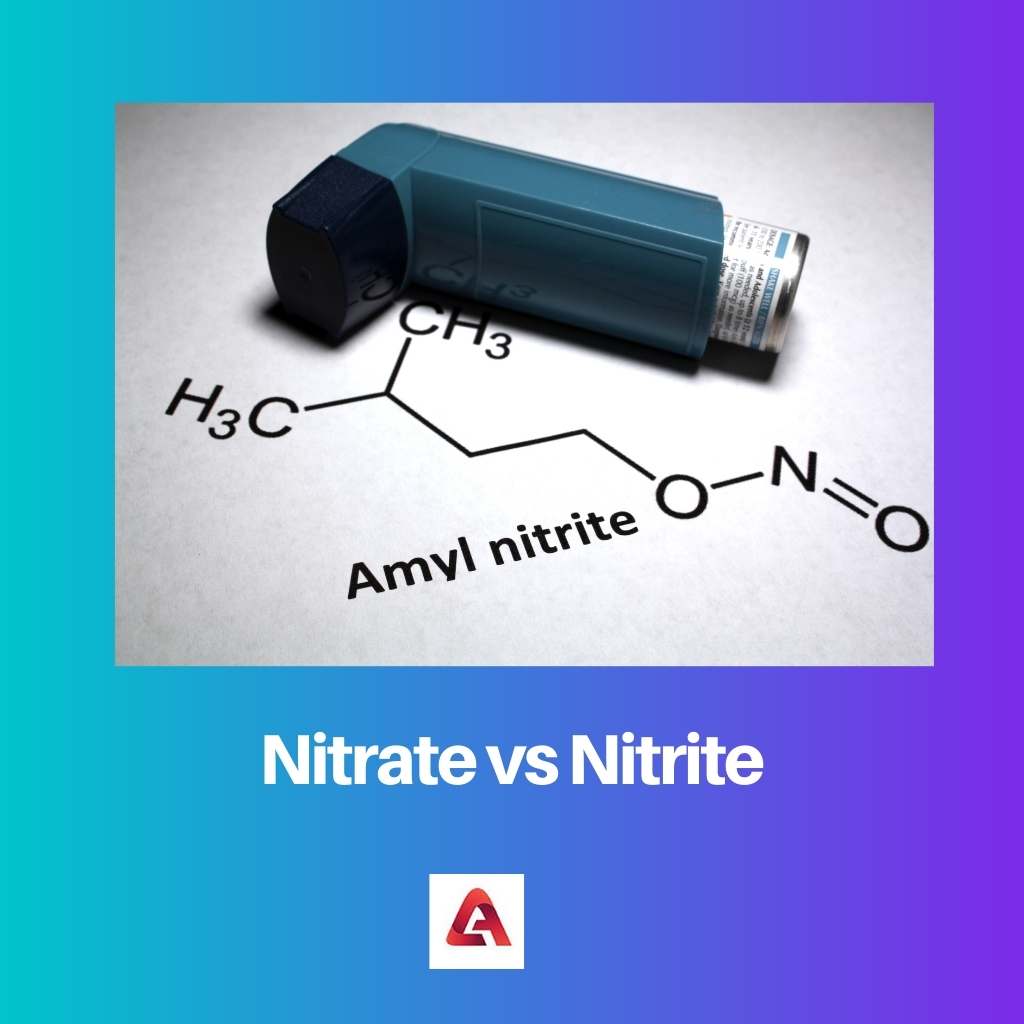Both nitrate and nitrite are used interchangeably. Nitrate and nitrite are inorganic compounds that are present in the nitrogen cycle. They can also be found in volcanic rocks. Humans consume nitrate in the form of vegetables.
Nitrate is an organic polyatomic ion (made up of one nitrogen and three oxygen atoms), whereas the latter one is an inorganic polyatomic ion (made up of one nitrogen and two oxygen atoms).
Key Takeaways
- Nitrates contain one nitrogen atom bonded to three oxygen atoms, while nitrites have one nitrogen atom bonded to two oxygen atoms.
- Nitrates serve as a vital nutrient for plants, whereas nitrites are food preservatives and can harm humans in large quantities.
- Bacteria in soil and water convert nitrates to nitrites, which can then be further reduced to nitrogen gas through denitrification.
Nitrate vs Nitrite
Nitrate (NO3-) is a naturally occurring compound found in soil, water, and many fruits and vegetables. In the human body, nitrate can be converted into nitrite by bacteria in the mouth and gut. Nitrite (NO2-) is a compound that is used as a food preservative, especially in cured meats.

Nitrate is a natural ion that is present in the nitrogen cycle. It is an inorganic compound that consists of nitrogen and oxygen.
Nitrate contains one nitrogen and three oxygen; it can be cut down or reduced to form nitrites. They are mainly used in fertilizers as well as explosives.
Nitrite is also a natural ion that is present in the nitrogen cycle. It is an inorganic compound that is made up of nitrogen and oxygen. It is formed with one nitrogen and two oxygen atoms.
It can be oxidized to be converted into nitrates. Mostly, nitrate is used in food preservatives.
Comparison Table
| Parameters of Comparison | Nitrate | Nitrite |
|---|---|---|
| Meaning | It is an inorganic polyatomic ion, present in the nitrogen cycle. | It is an inorganic polyatomic ion present in the nitrogen cycle. |
| Formation | One nitrogen atom and 3 oxygen atoms. | 1 nitrogen atom and 2 oxygen atoms. |
| Used in | Used as fertilizers, heart failures, and explosives. | It is mainly used in preservatives. |
| Oxidation number | The oxidation number is +5 | The oxidation number is +3 |
| Geometry | Trigonal planar geometry. | Bent molecular geometry. |
What is Nitrate?
Nitrate is an inorganic compound that is made up of oxygen and nitrogen. It is a part of the nitrogen cycle. The formation of nitrate is one nitrogen atom and three oxygen atoms.
The oxidation number for nitrate stands at +5. It has trigonal planar geometry. Nitrate can also be found in volcano rocks. Interestingly, the salt that is created from these ions can be completely dissolved in water.
Resonance structure also helps in the indication of nitrates. The nitrate or NO3 is inert. Speaking of conversion, the nitrate can be reduced to be converted into nitrites.
They are mainly used in agricultural fertilizers, and they are also used in medications (in tablet form) for treating heart failures, such as chest pain.
People consuming nitrate-infused tablets may experience dizziness, headache, low blood pressure, and sometimes even irritation of the skin (skin irritation has a very unlikely chance).
The nitrate forms a very strong nitric acid, and sometimes nitrates are also used in explosives.
When it comes to the negative side, too much nitrate consumption can be really dangerous for human health, and it is not always recommended for children and pregnant ladies to consume water with a high level of nitrate in it.

What is Nitrite?
Nitrite is also an inorganic compound that is also made up of oxygen and nitrogen, and it is a part of the nitrogen cycle. The formation of nitrite is one nitrogen atom and two oxygen atoms. It carries a “-1” charge.
The oxidation number for nitrite stands at +3. Just like nitrate, the nitrite can be oxidized to be converted into nitrates.
It also forms nitric acid (a weak acid). Nitrates are mainly used in food preservatives. This ion contains an asymmetrical structure wherein both the nitrogen and oxygen bonds contain an equal length and angle of hundred and fifteen degrees.
Same as nitrate, nitrite is also dangerous if it is too much consumption. Too much consumption of nitrite is dangerous for children.
Children consuming nitrite have a particular effect on their haemoglobin (they consume water with a formula containing high levels of nitrite). Many infants died due to heavy consumption of nitrite.
On the other hand, some studies say that nitrite can damage the body cells and cause cancer. If a person’s urine test indicates the presence of nitrate, it means the person has an infection in their urinary tract.
Nitrite is also used as an antidote for cyanide poison.
Main Differences Between Nitrate and Nitrite
- Nitrate and nitrite are inorganic polyatomic ions in the nitrogen cycle and comprise nitrogen and oxygen. They differ based on their structure and compounds.
- Nitrate is formed with one nitrogen and three oxygen atoms, whereas nitrite is formed with one nitrogen and two oxygen atoms.
- The oxidation number of nitrates stands at +5, whereas the oxidation number of nitrites stands at +3.
- Nitrite is mainly used in food preservatives, whereas nitrate is mainly used in agriculture fertilizers, explosives, and even heart failure treatments.
- In terms of geometry, nitrate contains a trigonal planar geometry, whereas nitrite contains a bent molecular geometry.





